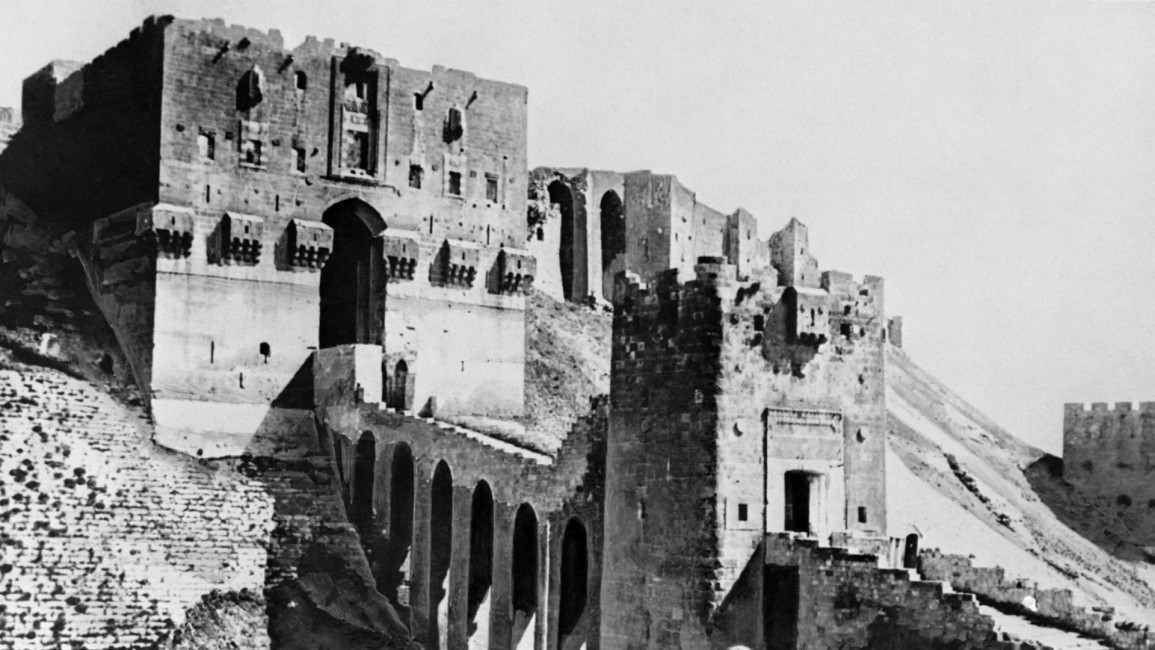
Today in History: The Aleppo Earthquake, 1138
Today in History: The Aleppo Earthquake, 1138
On 11 October 1138, an earthquake in northern Syria devastated large parts of Aleppo killing as many as 230,000 people.
2 min read
Aleppo's citadel suffered significant damage during the earthquake [AFP]
Long before bombs rained down on Aleppo and opposition areas were subject to a medieval-style siege by the Syrian regime, the city was struck by another devastating catastrophe.
Almost a thousand years ago, a punishing earthquake in Aleppo province struck killing tens of thousands of people. It would go down as one of the world's worst natural disasters.
On 11 October 1138, the walls of Aleppo's citadel crashed down and houses collapsed burying residents. According to the 15th century Egyptian chronicler Ibn Taghribirdi, the disaster killed around 230,000 people.
In the mid-late 12th century, Aleppo was a bustling city and home to tens of thousands of residents despite being subject to numerous upheavals from battles between Muslims and Crusaders, as well as competing Arab factions.
The northern Levant was then thrown into futher disarray by the punishing natural disaster.
The nearby Crusader citadel at Harem in modern-day Idlib governorate was levelled by the quake.
Similarly, Muslim-controlled Atarib - in what is now Aleppo province - was also flattened with 600 of the city's guard killed.
In Azrab, a village that was situated on the edge of the Kuros mountains, the ground is said to have opened in the middle of the settlement. This later caused the village to collapse in its entirety.
Amid the chaos, the holes and cracks that appeared in the stone walls of cities allowed for opportunistic raids by bands of Crusaders and Muslim factions. Aleppo's own citadel was breached to its east and west after the quake's shocks sent its blocks tumbling to the ground.
The quake was one of series of catastrophic shocks that that occurred in northern Syria between October and December 1138.
A little over a decade after the earthquake, Syria would finally be united under the rule of the Turkish atabeg [governor] Nur al-Din Zengi - whose name has been used by a controversial rebel group operating in Aleppo province.
Damascus, Aleppo and Edessa were brought together, and paved the way for the eventual re-conquest of Jerusalem from the Crusaders. That would begin a new chapter with Muslims ruling almost all the region in its entirety.
Almost a thousand years ago, a punishing earthquake in Aleppo province struck killing tens of thousands of people. It would go down as one of the world's worst natural disasters.
On 11 October 1138, the walls of Aleppo's citadel crashed down and houses collapsed burying residents. According to the 15th century Egyptian chronicler Ibn Taghribirdi, the disaster killed around 230,000 people.
In the mid-late 12th century, Aleppo was a bustling city and home to tens of thousands of residents despite being subject to numerous upheavals from battles between Muslims and Crusaders, as well as competing Arab factions.
The northern Levant was then thrown into futher disarray by the punishing natural disaster.
The nearby Crusader citadel at Harem in modern-day Idlib governorate was levelled by the quake.
Similarly, Muslim-controlled Atarib - in what is now Aleppo province - was also flattened with 600 of the city's guard killed.
In Azrab, a village that was situated on the edge of the Kuros mountains, the ground is said to have opened in the middle of the settlement. This later caused the village to collapse in its entirety.
Amid the chaos, the holes and cracks that appeared in the stone walls of cities allowed for opportunistic raids by bands of Crusaders and Muslim factions. Aleppo's own citadel was breached to its east and west after the quake's shocks sent its blocks tumbling to the ground.
The quake was one of series of catastrophic shocks that that occurred in northern Syria between October and December 1138.
A little over a decade after the earthquake, Syria would finally be united under the rule of the Turkish atabeg [governor] Nur al-Din Zengi - whose name has been used by a controversial rebel group operating in Aleppo province.
Damascus, Aleppo and Edessa were brought together, and paved the way for the eventual re-conquest of Jerusalem from the Crusaders. That would begin a new chapter with Muslims ruling almost all the region in its entirety.




